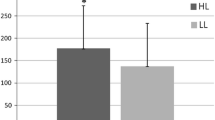Summary
The effect of three different training programmes on the maximal speed of an unloaded movement (a karate punch) was studied. Three movement variables were selected: maximal speed of the hand (νh,max), maximal speed of the shoulder (νs,max) and elbow extension speed\(\left( {\dot \Theta _E } \right)\) simultaneous with νh,max. The programmes were: training group 1 (TG 1,n = 8) -karate students, dynamic heavy progressive resistance exercise (incline situp and incline bench press) + punch bag exercise; training group 2 (TG 2,n = 8) - karate students, punch bag training; training group 3 (TG 3,n = 5) - no karate experience, dynamic heavy progressive resistance exercise (as in TG 1). The movement variables were calculated from chrono-cyclo photographic recordings of the punches (100 Hz). The level of significance was set at 5%. Sixteen weeks of training gave the following results: significant increases in dynamic strength in all the training groups (14%–53%). In TG 1 the νh, max increased significantly from 8.49 m·s−1, SD 1.19 to 9.35 m·s−1, SD 1.29 (10%); νs,max increased significantly in TG 1 by 32% (2.18 m·s−1, SD 0.56 to 2.87 m·s−1, SD 0.98) and in TG 2 by 14% (2.40 m·s−1, SD 0.61 to 2.74 m·s−1, SD 0.52), and in TG 3\(\left( {\dot \Theta _E } \right)\) at νh, max increased significantly from 28.6 rad · s−1, SD 4.3 to 32.2 rad·s−1, SD 4.5 (13%). No significant relationships between the changes in maximal muscle strength and the changes in movement speed were found. The significant changes in νh and νs among the karate trained subjects (TG 1 and TG 2) are ascribed to a change in the kinematics of the segmental motions induced by the karate training, to a movement pattern that takes advantage of the potentiating effect of a stretch-shortening cycle on muscle power output in flexor muscles of the shoulder and the extensor muscles of the elbow.
Similar content being viewed by others
References
Absaljamov TM, Zorin WP, Choose JM (1976) Kontraktionsgeschwindigkeit von Muskeln und ihre Veranderung im sportlichen Training 6:58–61
Asmussen E, Heebøll-Nielsen K, Molbech Sv (1959) Methods for evaluation of muscle strength. Communication Nr. 5, Polio Institute, Hellerup, Copenhagen
Atha J, Yeadon MR, Sandover J, Parsons KC (1985) The damaging punch. Br Med J 291:1756–1757
Berger R (1962) Effect of varied weight training programs on strength. Res Q 33:168–181
Bober T, Jakolski E, Nowacki Z (1980) Study on eccentric-concentric contraction of the upper extremity muscles. J Biomech 13:135–138
Bober T, Putnam CA, Woodworth GG (1987) Factors influencing the angular velocity of a human limb segment. J Biomech 20:511–521
Bonde-Petersen F, Graudal H, Hausen JW, Hvid N (1961) The effect of muscle contractions on dynamic muscle training. Eur J Appl Physiol 18:468–473
Bürhle M, Schmidtbleicher D (1977) Der Einfluss von Maximalkrafttraining auf die Bewegungsschnelligkeit. Leistungssport 7:7–10
Cavagna GA, Dusman B, Margaria R (1968) Positive work done by previous stretched muscle. J Appl Physiol 24:21–32
Chui EF (1964) Effects of isometric and dynamic weight training upon strength and speed of movement. Res Q 35:246–257
Clarke DH, Henry FM (1961) Neuromotor specificity and increased speed from strength development. Res Q 32:315–325
Dons B, Bollerup K, Bonde-Petersen F, Hancke S (1979) The effect of weight-lifting exercise related to muscle fiber composition and muscle cross-sectional area in humans. Eur J Appl Physiol 40:95–106
Häkkinen K, Komi PV, Tesch PA (1981) Effect of combined concentric and eccentric strength training and detraining on force/time, muscle fiber and metabolic characteristics of leg extensor muscles. Scand J Sports Sci (2):50–58
Hochmuth G (1981) Biomechanik der sportlichen Bewegungen. Sport, Berlin
Jöris HJ, van Muyen AJ, van Ingen Schenau GJ, Kemper HC (1985) Force, velocity and energy flow during the overarm throw in female handball players. J Biomech 18:409–414
Komi PV (1979) Neuromuscular performance: factors influencing force and speed production. Scand J Sports Med 1:2–15
Lindh M (1979) Increase of muscle strength from isometric quadriceps exercise at different knee angles. Scand J Rehabil Med 11:33–36
MacDougall JD, Elder GCB, Sale GB, Moroz JR, Sutton JR (1980) Effects of strength training and immobilization on human muscle fibers. Eur J Appl Physiol 43:25–34
McDonagh MJM, Davies CTM (1984) Adaptive response of mamalian skeletal muscle to exercise with high loads. Eur J Appl Physiol 52:139–155
Miller DI, Nelson CR (1976) Biomechanics of sports. Lea and Fibiger, Philadelphia
Moritani T, de Vries H (1979) Neural factors versus hypertrophy in time course of strength gain. Am J Phys Med 58:115–130
Oyama M (1972) This is karate. Japan Publications, Tokyo
Salter N (1955) The effect on muscle strength of maximum isometric and isotonic contractions at different repetition rates. J Physiol 130:109–113
Schmidtbleicher D (1980) Maximalkraft und Bewegungsschnelligkeit. Limpert
Schmidtbleicher D, Haralambie G (1981) Changes in contractile properties of muscle after, strength training in man. Eur J Appl Physiol 46:221–228
Siegel S, Castellan NJ jr (1988) Non-parametric statistics. McGraw-Hill Kogakusha, Tokyo
Thorstensson A, Karlsson J, Viitasalo JHT, Luhtanen P, Komi PV (1976) Effect of strength training on EMG of human skeletal muscle. Acta Physiol Scand 98:232–236
Whitley JD, Smith LE (1966) Influence of three different training programs on strength and speed of a limb movement. Res Q 37:132–142
Wilk SR, McNair RE, Feld MS (1983) The Physics of Karate. Am J Phys 51:783–790
Williams KR, Bernauer EM, Ramey MR, Waring WA (1978) A bio-mechanical analysis of individual muscle forces involved in elbow flexion (Abstract) Med Sci Sports (1979) 11: iii
Winter DA (1979) Biomechanics of human movement. Wiley, New York
Voigt M (1986) Changes in speed, acceleration, and impact force after heavy dynamic progressive resistance exercise and/or punch training (in Danish). Thesis, Laboratory for the Theory of Gymnastics, August Krogh Institute, University of Copenhagen, Denmark
Author information
Authors and Affiliations
Rights and permissions
About this article
Cite this article
Voigt, M., Klausen, K. Changes in muscle strength and speed of an unloaded movement after various training programmes. Europ. J. Appl. Physiol. 60, 370–376 (1990). https://doi.org/10.1007/BF00713501
Accepted:
Issue Date:
DOI: https://doi.org/10.1007/BF00713501




